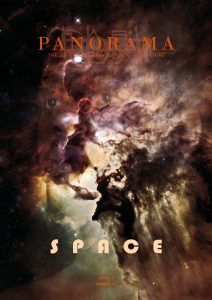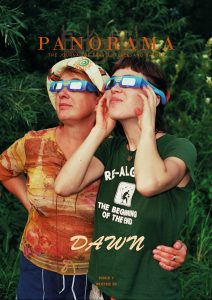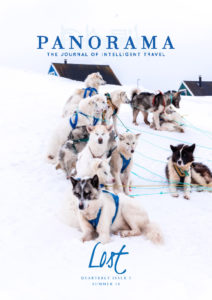Not long after it opened in the late 1980s, I journeyed the Karakoram Highway, through a region encased in amber, from northern Pakistan to Kashgar in far western China. The highway, called the KKH, roughly follows one of the ancient Silk Road routes on which silks and spices went west, and religion, gold, and other goods came east. Changes had come since two intrepid travellers, the Chinese Buddhist monk Faxian in the 4th century and Marco Polo in the 13th, trod the same route, but much also remained the same.
Along the highway, now as then, sharp peaks pierced the sky, emerald terraces tumbled down the flanks of mountains, houses clung to mountainsides, and apricots that gleamed like yellow topaz dried on rooftops. The stone houses, centuries old rock carvings, and the restive mountains exuded history. The people carried within them stories of years long gone and perhaps the genes of outsiders, including Alexander the Great’s soldiers and others who had come and gone. The past coexisted uneasily with changes arriving each day. It was a journey fraught with fear but also filled with excitement. I knew I was passing through a land of ancient history and geographic significance.
I knew about Marco Polo and the British explorers who had come through the region. However, Faxian was unknown to me. Early in the 5th century, Faxian set out for India to obtain Buddhist scriptures from monasteries there. He entered what is now Pakistan from China, probably through the 15,500-foot high Khunjerab Pass in the Karakoram Range.
More than 1,500 years separated Faxian’s journey and mine, but I felt similarities. The monk’s single-mindedness and courage to undertake a trek packed with peril is an inspiration. However, his narrative, A record of buddhistic kingdoms, is cryptic, short, and spare. He is economical with his words and descriptions.
Faxian entered the Karakoram Mountains from the north. Neither Faxian nor I travelled alone. He came with several monks; I went with my husband, Tim, and two friends. And we began our travel from the south.
His book contains only a few short chapters about his time within today’s Pakistan, and especially the area through which the KKH runs. But there are a couple of places where our journeys paralleled each other, such as where the KKH meets the Indus River, and a segment of the route from the Hunza Valley to the Khunjerab Pass.
From 1959 to 1979, 26,000 Chinese and Pakistanis toiled together to blast the KKH through some of the most formidable terrain in the world. The road extracted its price: nearly 1,200 workers lie at the bottom of rivers, buried in mudslides, or in the region’s cemeteries. The road climbs up and down, embraces rivers or mountains as need be. It forces itself through narrow valleys on ledges that in places drop straight down a thousand feet into the Indus, Gilgit, or Hunza Rivers.
Most journeys to China from Pakistan on the KKH, including ours, start from the capital, Islamabad, in the foothills of the Himalayas. We travelled in a van. Our driver, a young Pashtun with the unforgettable and grand name Jan-ay-Alam (life of the universe), was warm and friendly. He knew little English, but was a veteran of driving on the KKH.
Jan-ay-Alam rattled off our route. “We drive to Besham on the Indus River today. Next to Chilas and then to Gilgit. After that to Hunza and the town of Gulmit, and finally to Sost for your immigration and border crossing papers. At Sost I’ll say goodbye to you and another driver will take you through Khunjerab Pass.”
Our trip, unlike Faxian’s, was comfortable. We carried maps, guidebooks, music, food, and water in our van. Faxian says nothing of his mode of travel, but I imagine him plodding along on foot or on a horse or camel, slowly and carefully picking his way on narrow and often perilous paths high above river gorges, and then down through the lower valleys and plains.
Since Jan-ay-Alam spoke little English I sat up front with him, to keep him company and also to ask him about places we passed through. He was a traditional Pashtun, from a small village, and not used to women who looked him straight in the eye when they spoke to him. But he seemed pleased to have my company and immediately awarded me the honorific appellation of “Baji” or older sister, addressing me as “Shehla Baji” for the rest of the trip.
Early on we swept by cultivated plains and small towns, with barren and brown hills in the distance, a reminder of higher peaks ahead. Miles of fields green from recent rains contrasted with those lifeless hills.
We were slowly gaining elevation. As the plains began to recede, I thought of Koh-e-Qaf, a place from my childhood stories with eternally snow-capped mountains, clear lakes and rivers, and where beautiful paris or fairies, with flaxen hair and blue or green eyes, lived. I had believed Koh-e-Qaf and its fairies lay hidden among the tall mountains of Pakistan. It didn’t matter that it was imaginary; each passing mile increased my excitement about entering a land still remote, still magical.
Faxian’s sole mission was to procure Buddhist scriptures, and mine was to soak in the landscape through which we passed. We read guidebooks aloud and requested Jan-ay-Alam to stop for photos. I made mental notes and scribbled impressions in a notebook. I didn’t want to miss anything and wanted to etch each curve, each rise, each valley into my memory, even though I knew that time would erase much of it.
Closer to the mountains the road narrowed and ascended a river valley. Its surface became rough, strewn with stones. The mountains we clung to, and those across the river, were assemblages of dreary grey slag fused into huge forms.
The view was unchanging as far as the eye could see. But just when it appeared we would never escape from those ashen mountains, a summit would emerge in the distance, clad in snow as tantalising as vanilla icing on a cake. Settlements appeared when we rounded a bend, with cultivated plots of vegetables and grain in varying shades of green, reminiscent of the broad-brush strokes of a painting by Cezanne.
Our route converged with Faxian’s when we caught our first sight of the Indus River and crossed it at a place called Thakot, south of where he did. At Thakot I finally felt that I was on the KKH. Maybe it was the sight of the Indus that flowed placidly there but would rage farther north, the big sign with “Welcome to the Karakorum Highway”, or the bridge which took us across. It was among numerous bridges built by the Chinese, and was embellished with arches at each end, and small cement lions atop the supporting pillars on the sides.
We, of course, drove across the bridge. But Faxian, who crossed farther north on a narrow stretch of the Indus, wrote about using a suspension bridge of ropes. I saw the many local bridges crossing the rivers, a bed of planks lashed together with ropes that secured them to the sides. Whether his bridge was similar, I don’t know. But when I walked on one for a few feet, it swayed with each step, and I felt it could flip, and pitch me into the torrent of the Gilgit River below.
We spent our first night in Besham, a pleasant village, and the next day encountered one of the KKH’s most terrifying sections. The road was narrow as it twisted through the mountains and climbed at a steep angle. Jan-ay-Alam often manoeuvred the van through a maze of rocks. Sometime when another vehicle approached, he pulled so close to the mountainside that I could almost touch the rocks. Often we passed under huge overhanging rocks. We held our breath.
Below us the Indus rushed in a gorge and we could see skeletons of vehicle that had slipped from the road. Few of the guardrails, mostly large cement blocks placed every 10 feet, remained. Lack of guardrails reminded us that the local people let destiny rule their lives, and prevention carried little weight. Death seemed a constant on this road and was accepted with equanimity.
Jan-ay-Alam felt compelled to point out to me spots where trucks, buses, cars, and vans had plunged into the river. “Here is where the wedding party’s bus slid down on a rainy day, and there were no survivors.” Or, “This is where the driver of a mini-van was fiddling with the cassette player, lost control and crashed headlong into a potato truck. Very sad, very bad. Many dead.”
Faxian, too, felt terrified at this stretch. It is one of the few places where he allows himself to talk about the Karakoram. I can relate to his terror:
“The way was difficult and rugged, [running along] a bank exceedingly precipitous, which rose up there, a hill-like wall of rock… In former times men had chiseled paths along the rocks, and distributed ladders on the face of them, to the number altogether of 700…”
Faxian was searching for Buddhist scriptures, and it is known that Buddhism was present in the area. That Faxian sought shelter and food in monasteries is plausible. More than 50,000 pieces of Buddhist art, and inscriptions left by monks and travellers, remain along the KKH and the surrounding valleys. Faxian says nothing of monasteries, or monks, or scriptures in his brief writings about the area. We, however, stopped to see some of those inscriptions at Chilas, alongside the KKH. I wonder if Faxian saw those. Did he add his scribble to the rocks?
While I can only conjecture about Faxian’s accommodations and meals, I can, however, relate to one terror to which he alludes and we experienced. We were somewhere between Gilgit and Hunza, deep in the Karakoram and surrounded by towering spires of granite and snow-covered peaks, many reaching more than 25,000 feet. Here mountains are identified by an alphabet followed by a number, rather than names, including those that start with a K, such as the world’s second tallest, K2.
The KKH here winds through a geologically active terrain, subject to earthquakes. There is instability in the rocks and landslides are common. Travel is at elevations between 3,000 feet and 8,000 feet, and the road is often less a highway than a gravel strip that somehow manages not to slip down the side of the mountain on which it rests tenuously.
In this section, the designation “highway” seemed absurd. We were on a particularly narrow section, no more than a wide goat trail, high above the Hunza River which flowed swiftly to the south. Across the river we could see remnants of the ancient Silk Road, and watchtowers where people kept a look out for invaders.
We admired the mountains and terraced fields which broke the monotony of the stony landscape. We stopped often to take pictures of the villages with ancient-looking stone houses. We saw women readying trays of apricots and peaches for drying.
Each of us was lost in thought. Jan-ay-Alam, usually talkative, concentrated on the road and was quiet. He drove slowly, so slowly that I decided to stick my neck out the window for a better glimpse of sheer-faced granite giants.
Something went thunk, thunk, thunk on the van roof. Startled, I jerked my head in. A small landslide was in progress on the slope next to us. I turned toward Jan-ay-Alam, who was staring at the road and at small stones bouncing off its surface. He knew the perils of that road. We had to trust his judgment in that unpredictable terrain. “That was a small landslide, not many big stones,” Jan-ay-Alam finally said. “It was nothing, they happen all the time. We are used to them.”
Faxian must have encountered a few instances where the mountains let loose their fury. He ascribed natural phenomena, such as a landslide, to mythical creatures. “There are also among them venomous dragons, which, when provoked, spit forth poisonous winds, and cause showers of snow and storms of sand and gravel.”
It wasn’t dragons that caused those stones to clatter down mountains but we accepted that there was little we could do beyond hoping not to be caught in a slide.
We resumed our journey that day, inching ever closer toward Sost, the border town and our farewell to Jan-ay-Alam. Or so we thought. We were now wary of the those mountains and hoped to make it to Sost before the immigration officials closed for the day.
I was about to ask Jan-ay-Alam something when he slammed on the brakes. “Get out! Hurry! Hurry! All of you! Now! Run across to the other side. Don’t stop. Don’t look up. Don’t look down. Just run as fast you can. Okay, go now!”
We leaped out of the van. Boulders, rocks and stones skittered down the slope toward us as Jan-ay-Alam urgently yelled, “Get to the other side as quickly as you can, I will gun the van and drive it across.”
I felt my throat constrict as I ran through that menacing sound of rocks tumbling above me. I caught sight of some boulders the size of a small car from a previous slide, and feared if one that size was heading down above us.
The distance was maybe a thousand yards, but it felt like a mile. The landslide became noisier and I feared for Jan-ay-Alam. Before we knew it, we had run past the slide, and were safe.
The van halted next to us, unscathed and intact. Jan-ay-Alam reassured us: “Not too bad. Just a little slide. Only small rocks. Not big like that one,” pointing to a boulder the size of a pickup lying below the road. We smiled warily and clambered back in.
I looked back. The rocks continued to fall. Traffic on both sides came to a stop. But we continued toward the border town of Sost. We took our leave of Jan-ay-Alam, thanked him for his skilful driving, and exchanged addresses. We headed on toward Khunjerab Pass, and farther on into China, and through the Pamir Mountains toward Kashgar. Would I go back on the KKH again? You bet. A friend in Gilgit recently told me it is much improved, but also that there are more people in the area and more vehicles on the road. It could be another adventure.











